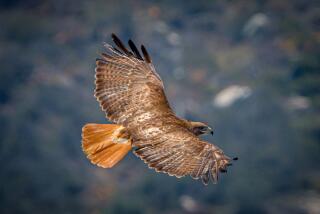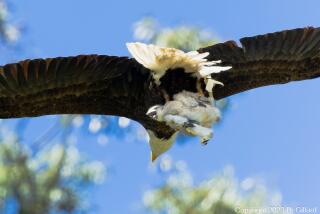Harris’ Hawks Socialize Over Hunts and Dinner
- Share via
ALBUQUERQUE — They’re chocolate-brown winged hunters with yellow landing gear and weapons systems, trained in the latest search-and-destroy maneuvers--the flush and ambush, the surprise pounce and the relay tactic.
They scan the tan sand dunes, the rolling desert hills dotted with mesquite, shinnery oak and patches of creosote brush.
They look for their victims--perhaps a jackrabbit or a cottontail--at Los Medanos, the dunes, 30 miles east of Carlsbad in southeastern New Mexico.
They fly in squadrons of two to six, brothers, sisters, mothers and fathers.
Biologist Jim Bednarz, after years of research, is fascinated with these unusual birds, called Harris’ hawks.
A full-size female hawk, with a wingspan of almost 4 feet, is 1 1/2 feet long from head to tail and weighs about 2 pounds, whereas an adult jackrabbit can weigh more than 4 1/2 pounds, Bednarz said.
“It’s very risky,” he said. “There are not very many predators that will take prey three times their size.”
But these birds of prey are not solitary hunters like other raptors, Bednarz said. They hunt in groups and, like humans, are social animals.
Bednarz, now director of higher education and research at the Hawk Mountain Sanctuary Assn. north of Kempton, Pa., said: “Both behaviors are rare.”
Predators like wolves, lions and African wild dogs cooperate when they hunt, he said, “but with birds, it’s debatable.”
“As far as the Harris’ hawk goes, what we’ve seen may be similar to an elementary step in the development of a complex human-like social system,” he said in a telephone interview.
“What the research suggests, at least with this one species, is that cooperation per se is the reason why these birds are social and that individuals do indeed get benefits by working with other individuals.
“Also, it shows the birds have levels of sophistication that a lot of men haven’t attributed to them.”
The Harris’ hawk is generally uncommon in the United States, Bednarz said, but one area of concentration is Los Medanos, 162 square miles of desert proposed to the U.S. Bureau of Land Management as the Los Medanos Raptor Area.
While studying birds of prey for his doctorate at the University of New Mexico from 1981 through 1985, Bednarz was prodded by a professor to investigate Harris’ hawks.
“The key question was: ‘Are these birds social, and (if so) why are they social?’ ” Bednarz said.
Earlier research in Arizona had suggested that Harris’ hawks were polyandrous--two males sharing one female, he said. There also were rumors Harris’ hawks nested in the fall, unusual for a bird.
“With that as my guiding question, I went out to see if those behaviors were found in New Mexico populations,” Bednarz said.
Bednarz found that the New Mexico Harris’ hawks did not appear to be polyandrous and that the extra birds actually were young hawks reared in the nesting areas in previous years.
“They are more or less extended family groups with old offspring,” he said.
He also found that pairs stayed together for several years and that after a baby left the nest, the parent hawks seemed to start another family immediately under certain conditions.
But, when Bednarz ended his dissertation research, he was not satisfied because, he said: “I wasn’t able to put my finger on the real cause of why this hawk
lived in groups. Why do those extra birds stay up to three years with those parents, which is very rare for birds?”
With a federal grant, he began a follow-up study in 1985, examining cooperative hunting, documenting the use of the Los Medanos area by raptors, studying the impact of human activity on the birds and developing a management plan to lessen that impact.
Bednarz and a research assistant, Tim Hayden, first trapped the birds, then attached transmitters about the size of a cookie with a thin, stainless-steel wire antenna trailing about 16 inches.
Once Bednarz and Hayden began tracking the birds, they started seeing some consistent hunting patterns.
Birds Take High Perch
The birds, which often roost separately, gear up before sunrise, Bednarz said.
“They simply fly up to a high perch and begin looking around for their buddies, and their buddies are doing the same thing,” he said. “One bird joins the other, then the other members of the group do the same thing.”
The group then breaks up into subgroups of two or three hawks, and those subgroups make short flights of 100 to 300 yards to another perch.
“You get the sense of the sub-units leapfrogging over the countryside,” Bednarz said. “The second group will hopscotch over the first group and the other group will be looking around.”
Bednarz has identified three hunting tactics.
The first is the surprise pounce.
Two sub-units, typically 100 yards apart, detect prey between them and both react.
“The unsuspecting prey is caught away from cover. The hawks converge en masse and make a quick kill,” Bednarz said.
Flush-and-Ambush Effort
The second tactic is dubbed the flush and ambush.
If a rabbit gets into a thick tangle of brush or a shallow burrow, the hawks will perch around the refuge at different heights.
“One, sometimes two, will then move in and try to encroach upon this safety zone where a rabbit is staying,” he said.
A hawk then will climb into the tangle of brush without a hope of getting the rabbit. But Bednarz said it’s part of the plan.
“His buddies are all over there and his buddies will come down and do the necessary chores,” Bednarz said.
The third maneuver is the relay tactic, mainly used on jackrabbits that tend to run and dodge quickly.
“When the jackrabbit starts to get out of the field of play or a hawk wants to run it faster, one of the hawks in the party flying above will dive. The rabbit will dodge the other way.
“The hawk that dove just fell out of pursuit, but his buddies still in the air or perched high will continue the chase. There will be a switch in the lead.”
The hawks continue to pass the lead until one of the hawks gets the rabbit, bringing the rest of the hunting group to a sudden stop.
There is then a family feast.
More to Read
Sign up for Essential California
The most important California stories and recommendations in your inbox every morning.
You may occasionally receive promotional content from the Los Angeles Times.













